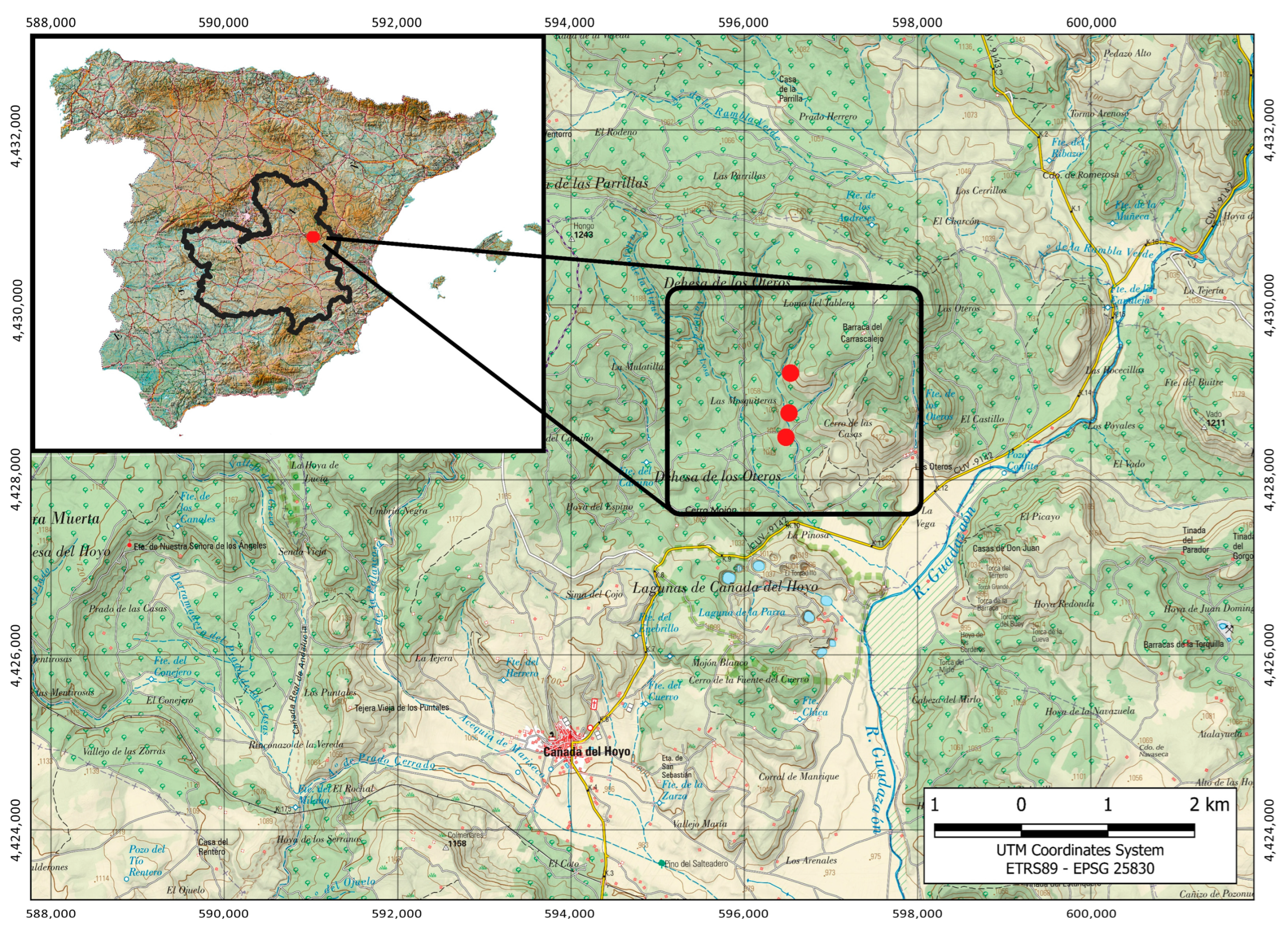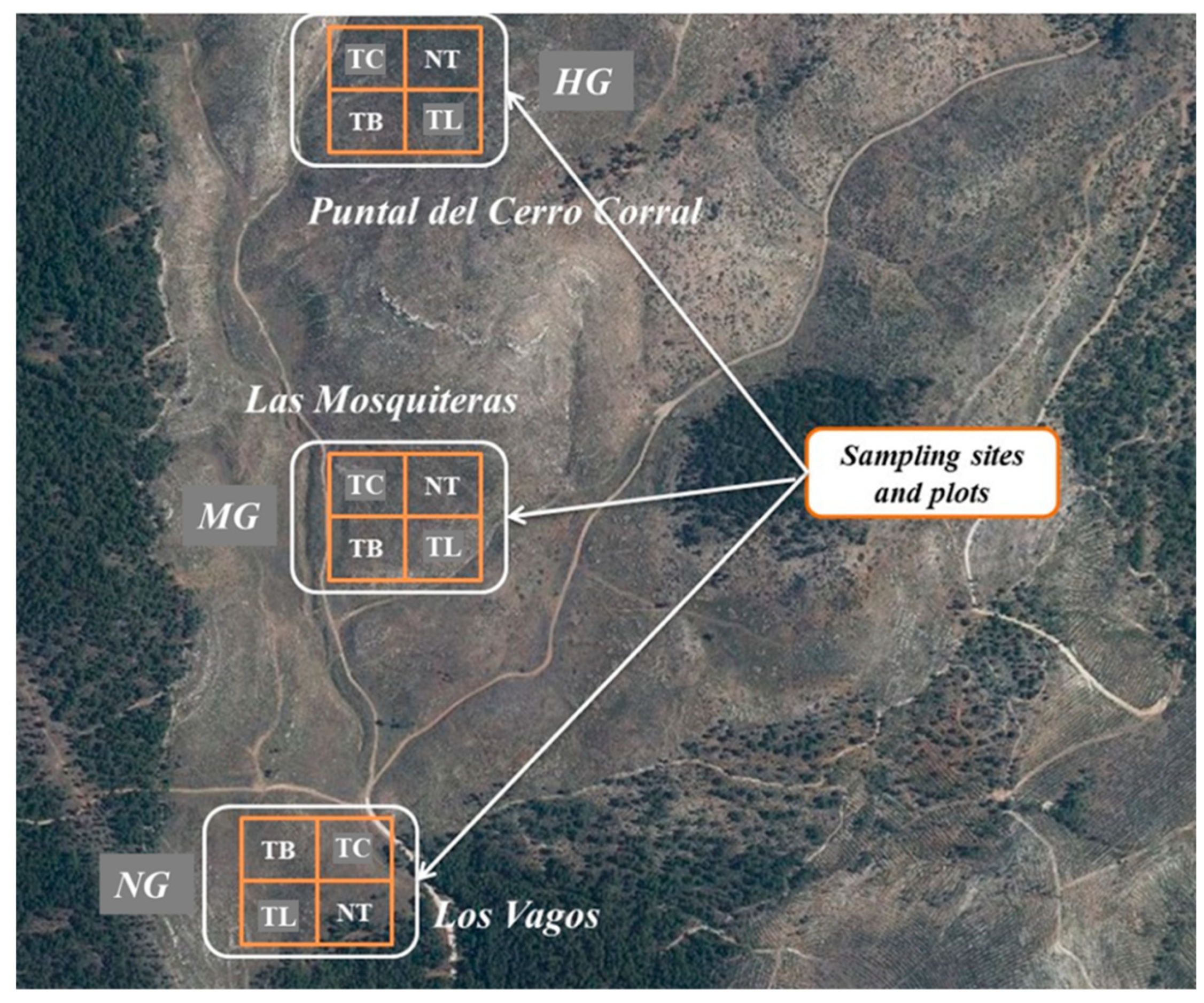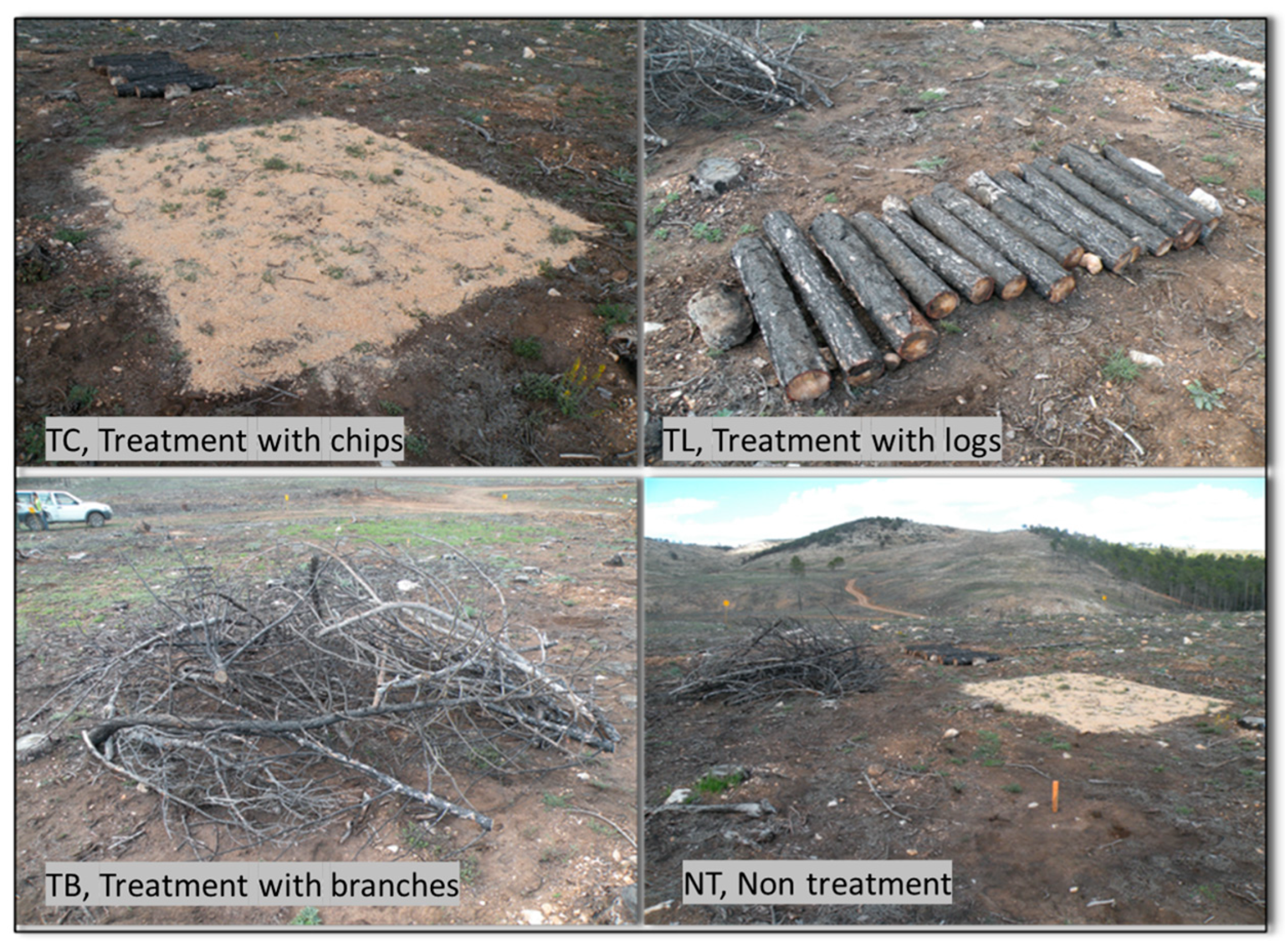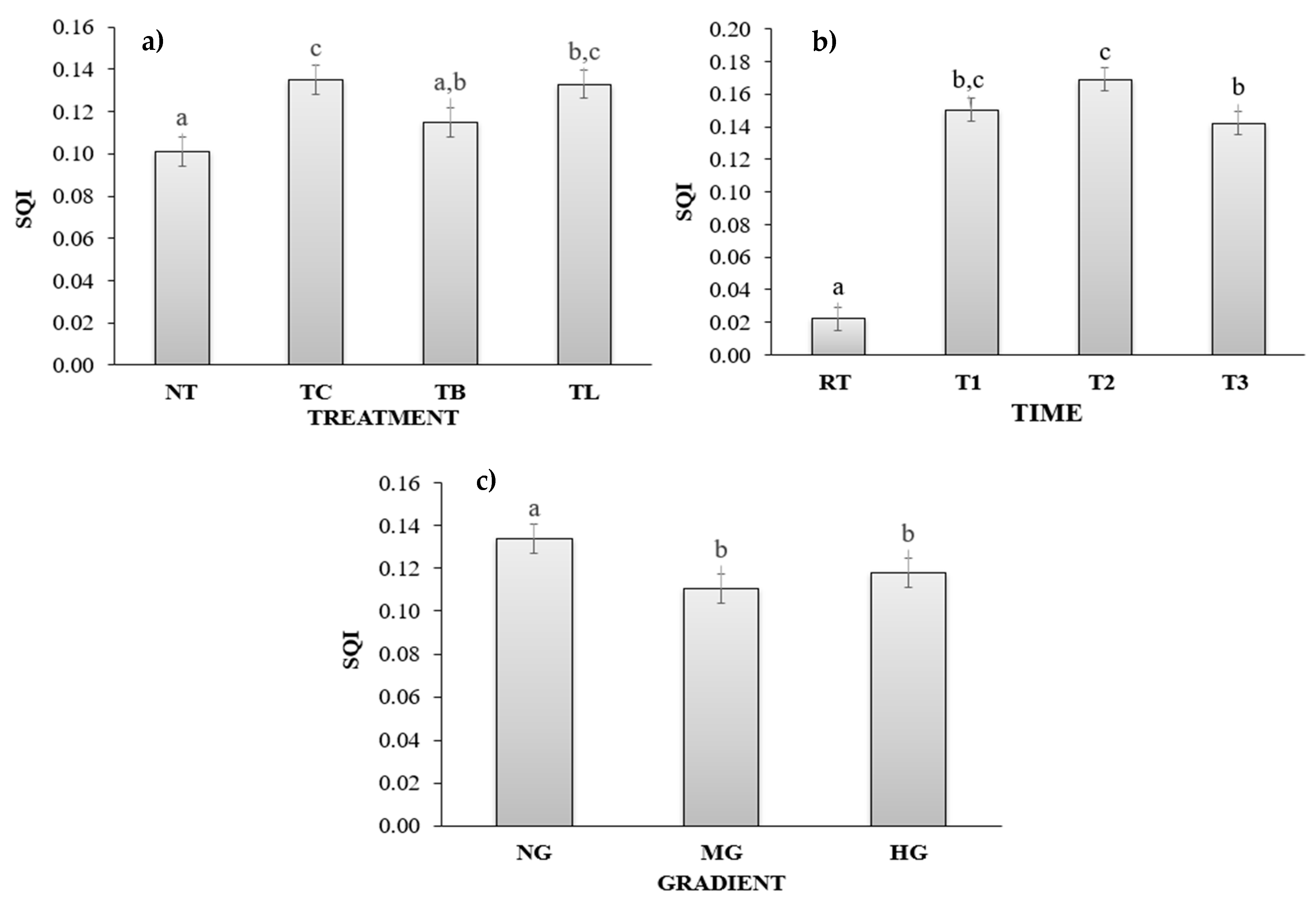Application of a Soil Quality Index to a Mediterranean Mountain with Post-Fire Treatments
Abstract
1. Introduction
2. Materials and Methods
2.1. Study Area and Experimental Design
2.2. Soil Sampling
2.3. Physicochemical, Microbiological, and Biochemical Characterization of Treated Soils
2.4. Soil Quality Index Applied (SQI)
2.5. Statistical Analysis
3. Results
3.1. Physicochemical, Microbiological, and Biochemical Characterization of Treated Soils
3.2. Application of Soil Quality Index (SQI)
4. Discussion
4.1. Physicochemical, Microbiological, and Biochemical Characterization of Treated Soils
4.2. Evaluation of Soil Quality Index (SQI)
5. Conclusions
Author Contributions
Funding
Data Availability Statement
Acknowledgments
Conflicts of Interest
References
- Zornoza, R.; Mataix-Solera, J.; Guerrero, C.; Arcenegui, V.; Mataix-Beneyto, J.; Gómez, I. Validating the effectiveness and sensitivity of two soil quality indices based on natural forest soils under Mediterranean conditions. Soil Biol. Biochem. 2008, 40, 2079–2087. [Google Scholar] [CrossRef]
- Zornoza, R.; Acosta, J.A.; Bastida, F.; Domínguez, S.G.; Toledo, D.M.; Faz, A. Identification of sensitive indicators to assess the interrelationship between soil quality, management practices and human health. Soil 2015, 1, 173–185. [Google Scholar] [CrossRef]
- Bünemann, E.K.; Bongiorno, G.; Bai, Z.; Creamer, R.E.; De Deyn, G.; de Goede, R.; Fleskens, L.; Geissen, V.; Kuyper, T.W.; Mäder, P.; et al. Soil quality—A critical review. Soil Biol. Biochem. 2018, 120, 105–125. [Google Scholar] [CrossRef]
- Andrews, S.S.; Karlen, D.L.; Cambardella, C.A. The Soil Management Assessment Framework. Soil Sci. Soc. Am. J. 2004, 68, 1945–1962. [Google Scholar] [CrossRef]
- Bastida, F.; Luis Moreno, J.; Teresa, H.; García, C. Microbiological degradation index of soils in a semiarid climate. Soil Biol. Biochem. 2006, 38, 3463–3473. [Google Scholar] [CrossRef]
- Glover, J.D.; Reganold, J.P.; Andrews, P.K. Systematic method for rating soil quality of conventional, organic, and integrated apple orchards in Washington State. Agric. Ecosyst. Environ. 2000, 80, 29–45. [Google Scholar] [CrossRef]
- Pausas, J.G.; Llovet, J.; Rodrigo, A.; Vallejo, R. Are wildfires a disaster in the Mediterranean basin? A review. Int. J. Wildland Fire 2008, 17, 713–723. [Google Scholar] [CrossRef]
- Lloret, F.; Zedler, P.H. The effect of forest fire on vegetation. In Fire Effect on Soils and Restoration Strategies; Cerdá, A., Robichaud, P.R., Eds.; CRC Press: Boca Raton, FL, USA, 2009; pp. 257–285. [Google Scholar]
- Wagenbrenner, J.; MacDonald, L.; Rough, D. Effectiveness of three post-fire rehabilitation treatments in the Colorado Front Range. Hydrol. Process. 2006, 20, 2989–3006. [Google Scholar] [CrossRef]
- Robichaud, P.; Lillybridge, T.; Wagenbrenner, J. Effects of postfire seeding and fertilizing on hillslope erosion in north-central Washington, USA. Catena 2006, 67, 56–67. [Google Scholar] [CrossRef]
- Robichaud, P.R.; Beyers, J.L.; Neary, D.G. Evaluating the Effectiveness of Postfire Rehabilitation Treatments; U.S. Department of Agriculture, Forest Service, Rocky Mountain Research Station: Fort Collins, CO, USA, 2000; 85p. [Google Scholar]
- Pausas, J.G.; Bladé, C.; Valdecantos, A.; Seva, J.P.; Fuentes, D.; Alloza, J.A.; Vilagrosa, A.; Bautista, S.; Cortina, J.; Vallejo, R. Pines and oaks in the restoration of Mediterranean landscapes of Spain: New perspectives for an old practice—A review. Plant Ecol. 2004, 171, 209–220. [Google Scholar] [CrossRef]
- Albaladejo, J.; Martinez-Mena, M.; Roldan, A.; Castillo, V. Soil degradation and desertification induced by vegetation removal in a semiarid environment. Soil Use Manag. 1998, 14, 1–5. [Google Scholar] [CrossRef]
- Hernández Jiménez, A. Actuaciones de emergencia post-incendio en Aragón. In Presented at IV Jorn. Sobre Conserv. Y Rehabil. De Suelos En Ecosistemas Afect. Por Incendios For; Instituto de Investigación en Ciencias Ambientales de Aragón: Zaragoza, Spain, 2014. [Google Scholar]
- Marzano, R.; Garbarino, M.; Marcolin, E.; Pividori, M.; Lingua, E. Deadwood anisotropic facilitation on seedling establishment after a stand-replacing wildfire in Aosta Valley (NW Italy). Ecol. Eng. 2013, 51, 117–122. [Google Scholar] [CrossRef]
- Perera, A.; Buse, L. Ecology of Wildfire Residuals in Boreal Forests; Wiley-Blackwell: Chichester, UK, 2014. [Google Scholar]
- Wic Baena, C.; Andrés-Abellán, M.; Lucas-Borja, M.E.; Martínez-García, E.; García-Morote, F.A.; Rubio, E.; López-Serrano, F.R. Thinning and recovery effects on soil properties in two sites of a Mediterranean forest, in Cuenca Mountain (South-eastern of Spain). For. Ecol. Manag. 2013, 308, 223–230. [Google Scholar] [CrossRef]
- Martínez-García, E.; Miettinen, H.; Rubio, E.; García-Morote, F.A.; Andrés-Abellán, M.; López-Serrano, F.R. Effects of post-fire management practices and slope-aspect on medium-term Spanish black pine regeneration: Implications of using a direct seeding strategy in burnt areas. Eur. J. For. Res. 2018, 137, 527–540. [Google Scholar] [CrossRef]
- Jones, A.; Montanarella, L.; Jones, R. Soil Atlas of Europe; The European Soil Bureau, Joint Research Centre: Bruxelles, Belgium, 2005; Volume JRC32396. [Google Scholar]
- García-Morote, F.; Martínez-García, E.; Andrés-Abellán, M.; Caballero, E.; Miettinen, H.; López-Serrano, F. Direct Seeding of Pinus halepensis Mill. for Recovery of Burned Semi-Arid Forests: Implications for Post-Fire Management for Improving Natural Regeneration. Forests 2017, 8, 353. [Google Scholar] [CrossRef]
- Walkley, A.; Black, I.A. An examination of the Degtjareff method for determining soil organic matter, and a proposed modification of the chromic acid titration method. Soil Sci. 1934, 37, 29–38. [Google Scholar] [CrossRef]
- Bremner, J.M. Inorganic Forms of Nitrogen. In Methods of Soil Analysis; Wiley: Hoboken, NJ, USA, 1965; pp. 1179–1237. [Google Scholar]
- Olsen, S.R.; Sommers, L.E. Phosphorus. In Methods of Soil Analysis; Soil Science Society of America: Madison, WI, USA, 1983; pp. 403–430. [Google Scholar]
- Garcia, C.; Hernandez, T.; Roldan, A.; Martin, A. Effect of plant cover decline on chemical and microbiological parameters under Mediterranean climate. Soil Biol. Biochem. 2002, 34, 635–642. [Google Scholar] [CrossRef]
- Kandeler, E.; Stemmer, M.; Palli, S.; Gerzabek, M.H. Xylanase, Invertase and Urease Activity in Particle—Size Fractions of Soils. In Effect of Mineral-Organic-Microorganism Interactions on Soil and Freshwater Environments; Berthelin, J., Huang, P.M., Bollag, J.M., Andreux, F., Eds.; Springer US: Boston, MA, USA, 1999; pp. 275–286. [Google Scholar]
- Tabatabai, M.A.; Bremner, J.M. Use of p-nitrophenyl phosphate for assay of soil phosphatase activity. Soil Biol. Biochem. 1969, 1, 301–307. [Google Scholar] [CrossRef]
- Andrés-Abellán, M.; Wic-Baena, C.; López-Serrano, F.R.; García-Morote, F.A.; Martínez-García, E.; Picazo, M.I.; Rubio, E.; Moreno-Ortego, J.L.; Bastida-López, F.; García-Izquierdo, C. A soil-quality index for soil from Mediterranean forests. Eur. J. Soil Sci. 2019, 70, 1001–1011. [Google Scholar] [CrossRef]
- Cherubin, M.R.; Tormena, C.A.; Karlen, D.L. Soil Quality Evaluation Using the Soil Management Assessment Framework (SMAF) in Brazilian Oxisols with Contrasting Texture. Rev. Bras. De Cienc. Do Solo 2017, 41. [Google Scholar] [CrossRef]
- Qi, Y.; Darilek, J.L.; Huang, B.; Zhao, Y.; Sun, W.; Gu, Z. Evaluating soil quality indices in an agricultural region of Jiangsu Province, China. Geoderma 2009, 149, 325–334. [Google Scholar] [CrossRef]
- Wymore, A.W. Model-Based Systems Engineering, 1st ed.; CRC Press: Boca Raton, FL, USA, 1993. [Google Scholar]
- Whittaker, C.W.; Anderson, M.S.; Reitemeier, R.F. Liming Soils: An Aid to Better Farming. In USDA Farmers’ Bulletins 2124; Government Printing Office: Washington, DC, USA, 1959. [Google Scholar]
- Li, J.; Tong, X.; Awasthi, M.K.; Wu, F.; Ha, S.; Ma, J.; Sun, X.; He, C. Dynamics of soil microbial biomass and enzyme activities along a chronosequence of desertified land revegetation. Ecol. Eng. 2018, 111, 22–30. [Google Scholar] [CrossRef]
- Davis, J.G.; Whiting, D. Choosing a Soil Amendment. Fact sheet number 7. Gard. Serv. Colo. State Univ. US Dep. Agric. Colo. Ctries. Coop. 2013. [Google Scholar]
- van Donk, S.J.; Lindgren, D.T.; Schaaf, D.M.; Petersen, J.; Tarkalson, D.D. Wood chip mulch thickness effects on soil water, soil temperature, weed growth and landscape plant growth. J. Appl. Hortic. 2011, 13, 91–95. [Google Scholar] [CrossRef]
- Breton, V.; Crosaz, Y.; Rey, F. Effects of wood chip amendments on the revegetation performance of plant species on eroded marly terrains in a Mediterranean mountainous climate (Southern Alps, France). Solid Earth 2016, 7, 599–610. [Google Scholar] [CrossRef]
- Rhoades, C.; Battaglia, M.; Rocca, M.; Ryan, M. Short- and medium-term effects of fuel reduction mulch treatments on soil nitrogen availability in Colorado conifer forests. For. Ecol. Manag. 2012, 276, 231–238. [Google Scholar] [CrossRef]
- Miller, E.; Seastedt, T. Impacts of woodchip amendments and soil nutrient availability on understory vegetation establishment following thinning of a ponderosa pine forest. For. Ecol. Manag. 2009, 258, 263–272. [Google Scholar] [CrossRef]
- Duan, Y.; Yang, J.; Song, Y.; Chen, F.; Li, X.; Awasthi, M.K.; Li, H.; Zhang, L. Clean technology for biochar and organic waste recycling, and utilization in apple orchard. Chemosphere 2021, 274, 129914. [Google Scholar] [CrossRef] [PubMed]
- Alcaniz, M.; Outeiro, L.; Francos, M.; Ubeda, X. Effects of prescribed fires on soil properties: A review. Sci Total Environ. 2018, 613–614, 944–957. [Google Scholar] [CrossRef] [PubMed]
- Khalili-Rad, M.; Nourbakhsh, F.; Jalalian, A.; Eghbal, M.K. The Effects of Slope Position on Soil Biological Properties in an Eroded Toposequence. Arid Land Res. Manag. 2011, 25, 308–312. [Google Scholar] [CrossRef]
- Barreto, A.C.; Galvão dos Santos Freire, M.B.; Soledade Nacif, P.G.; Reis Araújo, Q.; Freire, F.J.; Santos Borges Inácio, E.d. Fracionamento químico e físico do carbono orgânico total em um solo de mata submetido a diferentes usos. Rev. Bras. Ciência Do Solo 2008, 32, 1471–1478. [Google Scholar] [CrossRef][Green Version]
- Buol, S.W.; Southard, R.J.; Graham, R.C.; McDaniel, P.A. Soil Genesis and Classification, 6th ed.; John Wiley & Sons, Inc.: Chichester, UK, 2011; p. 543. [Google Scholar]
- DeBano, L.F. The role of fire and soil heating on water repellency in wildland environments: A review. J. Hydrol. 2000, 231–232, 195–206. [Google Scholar] [CrossRef]
- Wagenbrenner, J.W.; MacDonald, L.H.; Coats, R.N.; Robichaud, P.R.; Brown, R.E. Effects of post-fire salvage logging and a skid trail treatment on ground cover, soils, and sediment production in the interior western United States. For. Ecol. Manag. 2015, 335, 176–193. [Google Scholar] [CrossRef]
- David, B.a.; Clara, M.; Raquel, C. Soil Erosion and Conservation Measures in Semiarid Ecosystems Affected by Wildfires. In Soil Erosion; Danilo, G., Silvia, S., Eds.; IntechOpen: Rijeka, Croatia, 2011; chapter 5. [Google Scholar]
- Pérez-Cabello, F.; Echeverría, M.; Ibarra, P.; Riva, J. Effects of fire on vegetation, soil and hydrogeomorphological behavior in Mediterranean ecosystems. In Earth Observation of Wildland Fires in Mediterranean Ecosystems; Chuvieco, E., Ed.; Springer: Berlin/Heidelberg, Germany, 2009; pp. 111–128. [Google Scholar]
- Gómez-Aparicio, L.; Gómez, J.M.; Zamora, R.; Boettinger, J.L. Canopy vs. soil effects of shrubs facilitating tree seedlings in Mediterranean montane ecosystems. J. Veg. Sci. 2005, 16, 191–198. [Google Scholar] [CrossRef]
- Hedo, J.; Lucas-Borja, M.E.; Wic, C.; Andrés-Abellán, M.; de Las Heras, J. Soil microbiological properties and enzymatic activities of long-term post-fire recovery in dry and semiarid Aleppo pine (Pinus halepensis Mill.) forest stands. Solid Earth 2015, 6, 243–252. [Google Scholar] [CrossRef]
- Eliasson, Å.; Jones, R.J.A.; Nachtergaele, F.; Rossiter, D.G.; Terres, J.M.; Van Orshoven, J.; van Velthuizen, H.; Böttcher, K.; Haastrup, P.; Le Bas, C. Common criteria for the redefinition of Intermediate Less Favoured Areas in the European Union. Environ. Sci. Policy 2010, 13, 766–777. [Google Scholar] [CrossRef]




| Year | Season | Mean Temperature (°C) | Rainfall (mm) |
|---|---|---|---|
| 2012 | Summer | 18.11 | 37 |
| 2013 | Spring | 14.98 | 162 |
| 2014 | Summer | 24.81 | 56 |
| 2015 | Spring | 18.48 | 98 |
| Soil Properties a | Treatment b | Time c | Gradient d | ||||||||
|---|---|---|---|---|---|---|---|---|---|---|---|
| NT | TC | TB | TL | RT | T1 | T2 | T3 | NG | MG | HG | |
| M (%) | 13.17 ± 0.48 a | 15.57 ± 0.48 bc | 14.59 ± 0.48 bc | 16.67 ± 0.48 c | 2.57 ± 0.47 a | 21.24 ± 0.47 c | 20.68 ± 0.47 c | 15.4 ± 0.47 b | 15.76 ± 0.41 b | 14.09 ± 0.41 a | 15.13 ± 0.41 b |
| pH | 8.33 ± 0.01 b | 8.31 ± 0.01 b | 8.28 ± 0.01 a | 8.30 ± 0.01 ab | 8.11 ± 0.01 b | 7.94 ± 0.01 a | 8.46 ± 0.01 c | 8.68 ± 0.01 d | 8.31 ± 0.01 a | 8.31 ± 0.01 a | 8.31 ± 0.01 a |
| EC (mS·m−1) | 27.98 ± 1.12 a | 23.64 ± 1.12 ab | 25.42 ± 1.12 ab | 25.81 ± 1.12 b | 43.30 ± 1.12 c | 22.30 ± 1.12 b | 20.99 ± 1.12 b | 16.26 ± 1.12 a | 23.86 ± 0.90 a | 26.19 ± 0.90 ab | 27.09 ± 0.90 b |
| TOC (%) | 8.77 ± 0.33 a | 9.75 ± 0.33 b | 8.99 ± 0.33 ab | 9.49 ± 0.33 ab | 10.92 ± 0.33 c | 13.46 ± 0.33 d | 7.92 ± 0.33 b | 4.76 ± 0.33 a | 10.03 ± 0.29 b | 9.19 ± 0.28 b | 8.52 ± 0.29 a |
| N (%) | 0.26 ± 0.01 a | 0.29 ± 0.01 b | 0.29 ± 0.01 b | 0.30 ± 0.01 b | 0.24 ± 0.01 a | 0.38 ± 0.01 b | 0.26 ± 0.01 a | 0.25 ± 0.01 a | 0.30 ± 0.01 b | 0.30 ± 0.01 b | 0.26 ± 0.01 a |
| P (ppm) | 33.64 ± 2.59 a | 37.65 ± 2.59 a | 39.06 ± 2.59 a | 35.82 ± 2.59 a | 76.85 ± 2.59 c | 19.07 ± 2.59 a | 29.62 ± 2.59 b | 20.63 ± 2.59 a | 38.39 ± 2.24 a | 35.79 ± 2.24 a | 35.45 ± 2.24 a |
| CARB (mg CO32−·g−1) | 0.18 ± 0.01 a | 0.18 ± 0.01 a | 0.18 ± 0.01 a | 0.19 ± 0.01 a | 0.19 ± 0.01 b | 0.24 ± 0.01 c | 0.15 ± 0.01 a | 0.15 ± 0.01 a | 0.17 ± 0.01 a | 0.19 ± 0.01 a | 0.18 ± 0.01 a |
| BR (µg C-CO2 g−1·day−1) | 9.09 ± 0.47 a | 11.58 ± 0.47 b | 11.67 ± 0.47 b | 11.92 ± 0.47 b | 15.40 ± 0.48 c | 8.80 ± 0.47 a | 10.78 ± 0.47 b | 9.26 ± 0.47 a | 11.38 ± 0.40 b | 11.28 ± 0.40 b | 10.52 ± 0.40 a |
| MBC (μg C·g−1) | 388.1 ± 45.7 a | 524.8 ± 45.7 c | 441.1 ± 45.7 b | 417.8 ± 45.7 b | 114.7 ± 45.7 a | 257.1 ± 45.7 b | 675.2 ± 45.7 c | 924.7 ± 45.7 d | 493.5 ± 39.9 c | 421.1 ± 39.9 b | 414.2 ± 39.9 b |
| DHA (μmol (INTF)·g−1·h−1) | 0.02 ± 0.001 a | 0.02 ± 0.001 a | 0.02 ± 0.001 a | 0.02 ± 0.001 a | 0.03 ± 0.001 b | 0.02 ± 0.001 a | 0.02 ± 0.001 a | 0.02 ± 0.001 a | 0.02 ± 0.001 a | 0.03 ± 0.001 a | 0.02 ± 0.001 a |
| UA (μmol (N-NH4+)·g−1·h−1) | 2.11 ± 0.18 ab | 2.32 ± 0.18 b | 1.74 ± 0.18 a | 1.95 ± 0.18 ab | 1.77 ± 0.18 ab | 1.42 ± 0.18 a | 2.13 ± 0.18 b | 2.80 ± 0.18 c | 1.99 ± 0.16 a | 2.12 ± 0.16 a | 1.98 ± 0.16 a |
| APA (μmol (PNP)·g−1·h−1) | 10.36 ± 0.80 b | 8.43 ± 0.80 a | 10.08 ± 0.80 b | 8.51 ± 0.80 a | 13.34 ± 0.08 d | 5.08 ± 0.08 a | 8.31 ± 0.09 b | 10.64 ± 0.80 c | 8.31 ± 0.70 a | 8.98 ± 0.70 ab | 10.75 ± 0.70 b |
| β-GLU (μmol (PNP)·g−1·h−1) | 39.79 ± 0.95 b | 40.40 ± 0.95 b | 25.85 ± 0.95 a | 38.84 ± 0.95 b | 45.98 ± 1.00 b | 88.91 ± 1.00 c | 5.40 ± 0.71 a | 5.40 ± 0.71 a | 49.26 ± 0.82 b | 30.61 ± 0.82 a | 28.79 ± 0.82 a |
| C/N | 33.63 ± 1.21 b | 33.51 ± 1.21 b | 31.56 ± 1.21 a | 31.56 ± 1.21 a | 45.43 ± 1.21 d | 36.25 ± 1.21 c | 29.52 ± 1.21 b | 19.05 ± 1.21 a | 30.80 ± 1.05 a | 32.47 ± 1.05 b | 34.43 ± 1.05 b |
| q (CO2) (µg C-CO2·µg−1 C·day−1) | 0.28 ± 0.001 a | 0.22 ± 0.001 a | 0.23 ± 0.001 a | 0.26 ± 0.001 a | 0.08 ± 0.001 b | 0.06 ± 0.001 b | 0.02 ± 0.001 a | 0.01 ± 0.001 a | 0.02 ± 0.001 a | 0.03 ± 0.001 b | 0.03 ± 0.001 b |
| q (mC) (µg C-CO2·mg−1 COT·day−1) | 1.15 ± 0.06 a | 1.30 ± 0.06 ab | 1.49 ± 0.06 c | 1.41 ± 0.06 c | 0.87 ± 0.06 a | 1.14 ± 0.06 b | 1.45 ± 0.06 c | 1.90 ± 0.06 d | 1.39 ± 0.05 b | 1.36 ± 0.05 b | 1.27 ± 0.05 a |
| Variables | Treatment | Time | Gradient | Full Model | |||||
|---|---|---|---|---|---|---|---|---|---|
| F | p | F | p | F | p | F | R2 (%) | SEE | |
| SQI | 5.4 | <0.005 | 97.78 | <0.001 | 4.12 | <0.05 | 23.74 | 72.51 | 0.04 |
Disclaimer/Publisher’s Note: The statements, opinions and data contained in all publications are solely those of the individual author(s) and contributor(s) and not of MDPI and/or the editor(s). MDPI and/or the editor(s) disclaim responsibility for any injury to people or property resulting from any ideas, methods, instructions or products referred to in the content. |
© 2023 by the authors. Licensee MDPI, Basel, Switzerland. This article is an open access article distributed under the terms and conditions of the Creative Commons Attribution (CC BY) license (https://creativecommons.org/licenses/by/4.0/).
Share and Cite
Andrés-Abellán, M.; Picazo-Córdoba, M.I.; García-Saucedo, F.; Wic-Baena, C.; García-Morote, F.A.; Rubio-Caballero, E.; Moreno, J.L.; Bastida, F.; García, C.; López-Serrano, F.R. Application of a Soil Quality Index to a Mediterranean Mountain with Post-Fire Treatments. Forests 2023, 14, 1745. https://doi.org/10.3390/f14091745
Andrés-Abellán M, Picazo-Córdoba MI, García-Saucedo F, Wic-Baena C, García-Morote FA, Rubio-Caballero E, Moreno JL, Bastida F, García C, López-Serrano FR. Application of a Soil Quality Index to a Mediterranean Mountain with Post-Fire Treatments. Forests. 2023; 14(9):1745. https://doi.org/10.3390/f14091745
Chicago/Turabian StyleAndrés-Abellán, Manuela, Marta I. Picazo-Córdoba, Francisco García-Saucedo, Consolación Wic-Baena, Francisco A. García-Morote, Eva Rubio-Caballero, Jose L. Moreno, Felipe Bastida, Carlos García, and Francisco R. López-Serrano. 2023. "Application of a Soil Quality Index to a Mediterranean Mountain with Post-Fire Treatments" Forests 14, no. 9: 1745. https://doi.org/10.3390/f14091745
APA StyleAndrés-Abellán, M., Picazo-Córdoba, M. I., García-Saucedo, F., Wic-Baena, C., García-Morote, F. A., Rubio-Caballero, E., Moreno, J. L., Bastida, F., García, C., & López-Serrano, F. R. (2023). Application of a Soil Quality Index to a Mediterranean Mountain with Post-Fire Treatments. Forests, 14(9), 1745. https://doi.org/10.3390/f14091745







